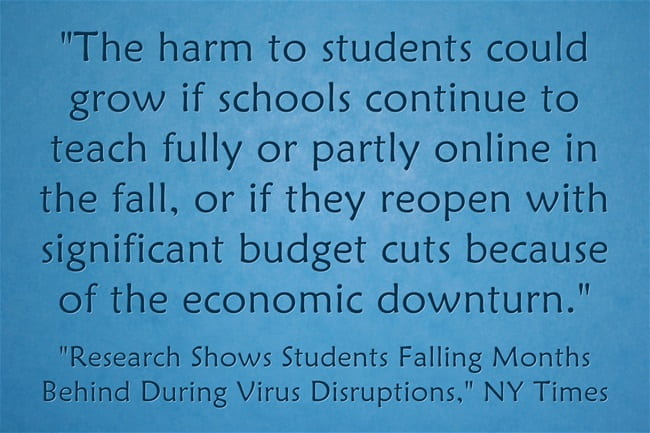Research Shows Students Falling Months Behind During Virus Disruptions is a new article by Dana Goldstein in The New York Times.
The article cites various studies warning of dire learning losses this year from school closures. One of the studies is from McKinsey & Company, which has a truly awful track record when it comes to education studies. One of the others is based on an online learning program, and the other on extrapolations primarily based on previously found summer learning loss.
Those studies may be correct, but I’m not entirely convinced (though if I’m wrong, it won’t be the first or last time). Here’s what I wrote in an Ed Week commentary:
Here, 70 percent of the school year had already been completed by the time we closed. Of the remaining 30 percent, one week was going to be spring break, and two weeks were going to be devoted to state testing, when not much learning happens because of all the disruption that testing causes. The last two weeks of school are not known as times of high academic engagement, and our seniors miss one of those weeks anyway. So, with my district as an example, we’re talking about most students in the United States missing about 15 percent of learning time from one school year, which is not a huge portion of a 12- or 13-year school career.
On top of this time analysis, a recent study suggests that students learn in the first half of a school year at about twice the rate they do in the second half. I think many teachers’ experience would support that conclusion.
The upshot? The vast majority of students in our schools would have come out of the shutdowns just fine, even if we did not do distance learning the way it’s being typically done. In most places, that has meant teachers trying to continue to teach everybody.
In my experience (and based on my conversations with numerous teachers around the country), I think the students who participated in remote learning “maintained” the learning they had gained this year, but did not learning anything new. And I do think what they didn’t learn, they can make-up next year. Of course, those that did not participate didn’t “maintain” and certainly “lost.” Nevertheless, as I said in my Ed Week commentary, I still wouldn’t characterize those losses as traumatic.
However, I do agree with the researchers that things will be bleak for students, especially for those in vulnerable populations (ELLs, special needs, others experiencing academic challenges) next year if online learning has to continue for any length of time. That’s why I hope districts recognize the difference between equality and equity. They can’t treat all students the same – students in vulnerable populations must receive additional support. For example, if only a quarter of students are coming in each day, it seems to me that schools need to create the conditions where these vulnerable student populations come in more often – even daily.
Whatever happens, things are going to be tough next year and will be compounded by budget cuts. Despite those challenges, I hope that districts are able to use creative means to support our most vulnerable students.
If not, I’m sure that next year I won’t have any disagreements with any researchers who suggest in June, 2021 that students will have been hurt – and hurt badly – by another round remote teaching.
Addendum: Here’s Matt Barnum, an experienced writer on education research, commenting on the bleak projections of learning loss in the studies cited in the article:
The projections here are compelling, depressing, and not surprising — but it's important to note these are still largely *just projections.* This is uncharted territory and we have little hard data on how much learning loss has actually occurred https://t.co/SI6qQj9JG0
— Matt Barnum (@matt_barnum) June 5, 2020




This is a great article that is actually highlighting a great problem that our children are facing all over the world. This is a global crisis infact What we feel is that the whole world educators should unite together to find sustainable solutions to tackle this issue.